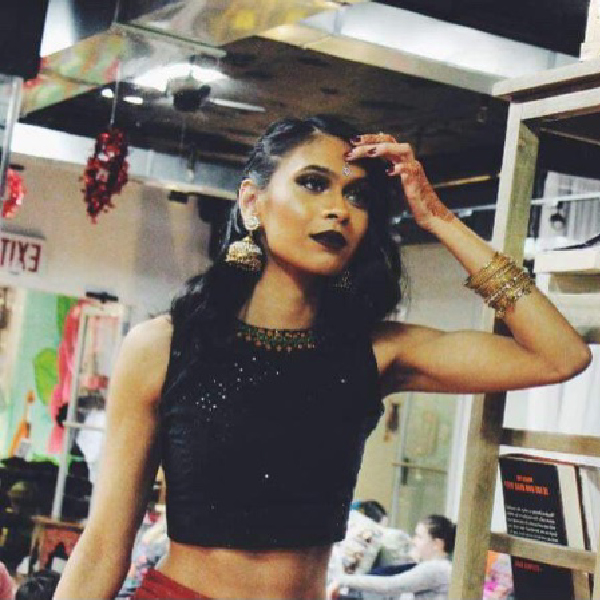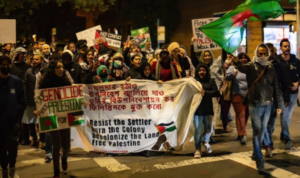Woman

It’s a chilly afternoon and I am in a local subway at the corner of East 84th and Lexington with my friend Amatan. Colloquially known as “Amy”, Amatan Noor is the creative director behind Bengali of New York’s recent campaign. Set to launch on Women’s Day, ‘Woman’ is a multimedia project tied to Amatan’s own original, unapologetic poetry. It celebrates six powerful and diverse Bengali women and weaves together a narrative of female empowerment and cultural diversity.
Dhara: So tell me a little bit about the project.
Amatan: I’m creating a short clip that features 5 very diverse Bengali women from different backgrounds. They are diverse in the way they carry themselves. They are diverse in terms of what they’re doing with their lives. They also look very different, but they’re all Bengali. That’s the one thing that they have in common. I’m very excited about it. We’ve been working on it together — you and I. You’ve taken a lot of the footage and photography and that’s something you’re passionate about. I’m glad we both get to explore our creative sides through this project. This gives us an opportunity to do something out of our comfort zones.
Dhara: So just circling back you had mentioned your project is combining the best of both worlds for you — your passion for your Bengali culture and that self-discovery along the way, too — can you elaborate when your love for poetry came to be?
Amatan: It really started when I was a junior in college and I realized that, while I wasn’t lonely in college in the physical sense — I had a lot of friends, I kept busy — I felt lonely in the sense that I was minority. I am a first generation immigrant and by not having a lot of Bengali friends or friends of color, I couldn’t always have deep conversations about my roots. I needed an outlet for the struggles and self-discoveries I was having but I didn’t want to always be your typical token women of color complaining about my surroundings. I used poetry to cope with my experiences. Not all my work has to do with being in the diaspora and being a woman of color; my work is something women of all backgrounds and races can relate to. I try to write for all women2 but a lot of my work does focus on women of color and people of the diaspora in general.


Want to add a caption to this image? Click the Settings icon.
Dhara: With so many prominent poets of color we see nowadays such as Rupi Kaur and Mahogony L. Browne, everyone has his or her unique style. What would you say describes your style?
Amatan: I don’t think the focus should be what makes the poems different, I think it is about what makes us learn from one another. What makes my work unique is I don’t fudge the truth, I don’t ever exaggerate anything just so it would get a more emotional reaction. I try to keep my work very realistic. I try to write for me and if it inspires others along the way it is just a bonus. In the age of photoshop and filters and enhancements, I feel that type of authenticity is what people are looking for. People are looking for things that are real.
Dhara: Definitely and we’re seeing a lot of the momentum for this project already on social media. Can you describe the current excitement for the project?
Amatan: I was actually a little surprised to see the momentum and to see the level that it is being picked up. I am happy it is getting a lot of attention from the Bengali community. Seeing the vastness of the community through this project is what I am the most excited about. I’m just happy to see we’re not as minuscule as I once thought we were. I want the attention we’re getting to be for the right reasons.
Dhara: I totally can relate. Even by being part of a different part of the diaspora, the diversity and community feeling is something I cherish. Even with all the women featured in the project, for instance, I sensed there was a sisterhood bond. Is that how you think everyone felt as we were wrapping up?
Amatan: I definitely think the women bonded. When we were taking individual shots they had a lot of time just to sit and talk to one another, and when we were leaving we saw them became a lot more comfortable with one another. Everyone was following each other on Instagram and even when we parted ways and went home they were posting the pictures. You can see the solidarity. They were the first to comment on each others’ pictures. I think they left with a smile on their faces and ready to keep it in touch. I hope we can maintain this bond after this project.
Dhara: I do remember seeing the exchanges of Instagram handles and post project photoshoots. However, taking this to the next level, how do you think social media may solidify the bond within the broader Bengali community? What do you think the strengths and weaknesses will be?
Amatan: The strengths are that as Bengali women, for the longest time, we’ve been told what to do and because of social media we will now be able to show other women and just Bengalis in general that we are able to take control of our own lives. We are able to take charge of our own narratives and we are able to do so in a guiltless manner and that is what I’m trying to do with my project. This is why I chose to feature very diverse women. I curated the video in a way that showed the world that we choose to be Bengali in different ways. Some of us wear our culture in a conservative way and some of us don’t. But we are all proud to be Bengali. Choosing to live one way doesn’t make us less or more Bengali. Our lifestyles shouldn’t hinder us from being strong, independent women. The age of social media helps us send those messages across. The downside to this is the instant criticism and cyberbullying. What you once received in person you can now get with the click of a button. Those things can be painful and difficult to face, and being on the receiving end of that can be really painful.
Dhara: I like how you said you should really be true to yourself even if it means wearing your culture conservatively or liberally. How do you want to empower those woman who are living conservatively but want to break out of that mold and live liberally?
Amatan: My advice is to be educated on our history and our religion. I’m going to mention an Instagram account @Bangladesh.story. It is an Instagram account curated to tell the Bangladeshi narrative pre- and post-liberation war. It is curated by this man who is based in Canada whose name is Mohiminol Khandaker. He is a law student and this is his passion project. He’s been reaching out to different organizations and different historical societies to come up with photos from back in the day. He posted this picture of women a couple days ago at Dhaka University — one of the most prominent colleges in Bangladesh, that’s where my mom went actually, and these women were wearing sarees with sleeveless blouses.
Even today wearing sleeveless blouses in some parts of Bangladesh is scandalous but women in the early 80’s were doing it. So when you look at our history we weren’t always like this. Somewhere along the way there was a shift in our culture. We need to get to the bottom of the religious influences that made us more conservative.
Bangladesh is a largely Muslim country and we need to study our religion and see how we interpret it. There are different way to be Muslim, just as there are different ways to be Bengali. We need to cultivate our religion in a way that is comfortable that allows us to breathe and allows us to live in our own skin without self-loathing without harboring hatred towards each other. No religion and nationality was built on the idea of hatred for another and we need to focus on that as Bengalis.
Dhara: I like what you said about making people comfortable in their own skin without judging someone else for what they are. I have no doubt this project will be successful and seeing the momentum building up what do you think the future is going to hold for Amatan?
Amatan: We don’t know until we launch the project and get feedback. What I want to personally do is write and continue to create. I think a lot of times creatives suffer from exhaustion because they think they have to constantly produce to be a creative. That’s not my mindset. I think allowing yourself to breathe is important and so is taking a hiatus to get inspired again. I’m going to take a step back and listen to what people have to say.
Dhara: I’m proud to see your vision come into fruition. It is remarkable and I have no doubt it will be a success.
Amatan: Thank you for all your help. I don’t think this project would be what it is without your hard work either and we honestly did it together.
Dhara: I think me being from the diaspora, I appreciate anything to get someone’s voice — I’m supportive of that.
Amatan: I think in pre-partition India we were all the same and therefore, I think we should be united. In the face of discrimination, we are all acknowledged the same anyways. So we are stronger together. We need to stick together and get our voices out. This project is a prime example of how we were able to do that.
Dhara: That’s true. If you build unity in a smaller community, the effect trickles. Solidarity is often contagious… and just lastly If you had to summarize today’s Bengali woman how would you describe her?
Amatan: She’s reaching new heights but she’s rooted.
Dhara Singh (producer) is currently a Master’s student at Columbia University Graduate School of Journalism. She loves delving into topics that challenge orthodox ways of thinking. In her free time, she loves photography, reading memoirs and blogging. Her work has been featured on Browngirl Magazine and Thrive Global. “Woman” is her first partnership with Amatan. You can view more of her work at dharasingh.org or follow her on IG: @dsinghx
Read More
The Legacy of Boi Mela
Every year in February, the month-long national book fair welcomes...
Read MoreMillennial Amma: How to Explain a Global Crisis As a Parent
Rumki Chowdhury shares tips for how to talk to children...
Read MoreBegum Rokeya’s Millennials
A tribute to a pioneering Bengali feminist writer, educator and...
Read More



